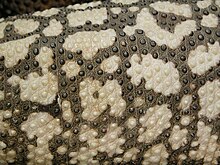皮内成骨 编辑
皮内成骨(英语:osteoderm)是在真皮下中形成鳞片、板或其他结构的骨性沉积物。 在许多现存和已灭绝的爬行动物和两栖动物中都发现了皮内成骨,包括蜥蜴类、鳄类、蛙类、各种恐龙(最著名的是装甲类的甲龙和剑龙)、植龙目、楯齿龙目、鱼龙目以及离片椎目动物。


皮内成骨在哺乳动物中并不常见,但在许多异关节总目动物中被发现,如犰狳、已灭绝的雕齿兽和大地懒等。 皮内成骨已在许多不同的动物群系中独立发展[1] 。犰狳的皮内成骨被认为在皮下真皮组织中发育[2]。皮内成骨被视为相似物(analogues)而非同源(homologues),故不能作为单系群的必要标准。然而,这些结构是从所有种类的羊膜动物共有的鳞甲中衍生出来的,这便是是所谓的深同源性(deep homologues)的一个例子[3]。在许多情况下,皮内成骨可能会起到防御装甲的作用。成骨细胞由骨组织组成,并从该生物的胚胎发育过程中的神经脊细胞衍生而来[4]。
现代鳄类的皮内成骨具有大量血管[5] ,既可以用作装甲,也可以用作热交换器[6] ,从而使这些大型爬行动物能够迅速升高或降低温度。 另一个功能是中和酸中毒,这种酸中毒是由于长时间浸泡在水下而导致血液中二氧化碳的积累所致[7] 。皮内成骨中的钙和镁将释放碱性离子到血液中,作为防止体液酸化的缓冲剂[8]。
参考资料
编辑- ^ Hill, R.V. Comparative anatomy and histology of xenarthran osteoderms. Journal of Morphology. December 2006, 267 (12): 1441–1460. PMID 17103396. doi:10.1002/jmor.10490.
- ^ Nasoori, Alireza. Formation, structure, and function of extra‐skeletal bones in mammals. Biological Reviews. 2020 [2020-08-09]. doi:10.1111/brv.12597. (原始内容存档于2020-07-27).
- ^ Vickaryous, M.K.; Hall, B.K. Development of the dermal skeleton in Alligator mississippiensis (Archosauria, Crocodylia) with comments on the homology of osteoderms. Journal of Morphology. April 2008, 269 (4): 398–422. PMID 17960802. doi:10.1002/jmor.10575.
- ^ Vickaryous, Matthew K.; Sire, Jean-Yves. The integumentary skeleton of tetrapods: origin, evolution, and development. Journal of Anatomy. 2009-04-01, 214 (4): 441–464. ISSN 1469-7580. PMC 2736118 . PMID 19422424. doi:10.1111/j.1469-7580.2008.01043.x (英语).
- ^ Clarac, F.; Buffrénil, V; Cubo, J; Quilhac, A. Vascularization in Ornamented Osteoderms: Physiological Implications in Ectothermy and Amphibious Lifestyle in the Crocodylomorphs?. Anatomical Record. 2018, 301 (1): 175–183. PMID 29024422. doi:10.1002/ar.23695 (英语).
- ^ Clarac, F.; Quilhac, A. The crocodylian skull and osteoderms: A functional exaptation to ectothermy?. Zoology. 2019, 132: 31–40. PMID 30736927. doi:10.1016/j.zool.2018.12.001.
- ^ Jackson, DC.; Andrade, D.; Abe, AS. Lactate sequestration by osteoderms of the broad-nose caiman, Caiman latirostris, following capture and forced submergence.. Journal of Experimental Biology. 2003, 206 (Pt 20): 3601–3606. PMID 12966051. doi:10.1242/jeb.00611.
- ^ Antacid armour key to tetrapod survival. ABC Science. 2012-04-24 [6 March 2017]. (原始内容存档于2019-01-18).